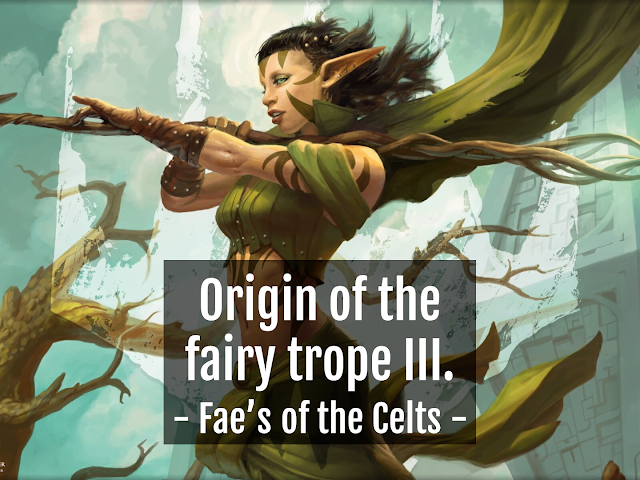Origin of the fairy trope III. - Ireland and the Tuatha
To be honest, I was intimated by the amount of raw lore surrounding today’s topic, but it’s pretty much unavoidable when speaking about fairies. From Shakespear and Tolkien to Neil Gaiman and Sarah J. Maas, writers love drawing on the mysterious Celts (especially their Irish variant) when portraying fae creatures, because this was basically the culture that made them famous. It’s the first thing people think about hearing the word “fairy”, so let us not tally longer and plunge into this monster of a trope.
In Irish-Celtic
mythology, the Tuath Dé, or Tuatha dé Danann (“the tribe of the goddess Danu”
or “the tribe of the gods”) are a supernatural race of people, making up most
of the region’s pre-christian pantheon, filling every must-have god role (like we talked about in here). As belief
holds, they dwelled in the Otherworld, a plane specifically for supernatural
creatures accessible through ancient passage tombs (a type of underground
burial mound with a narrow, mostly stone passageway). If that sounds familiar,
it’s because you can read something oddly similar in feel in Tolkien’s The Fellowship
of the Ring, when the hobbits meet Tom Bombadil.
I. Battle of the six armies - An island under constant invasion
The Tuatha’s
greatest enemies were the Fomorians; another supernatural race associated with
the destructive forces of nature, typically portrayed as monsters and sea raiders.
According to the “Lebor Gabála Érenn”, or the Book of Invasions, the two tribes
were even at war with each other, peaking at the Battle of Mag Tuired with the
Thuata’s victory. This book claims that Ireland was taken six times, although
previous nations sometimes survived the coming of the next, leading to stories
about mixed heroes descending from two different tribes.
To give
some concrete points, and give a glimpse into just how many invasions Ireland
suffered, here’s how the Lebor Gabála Érenn tells history: the first nation
settling in Ireland was Cessair and his followers, who came before “the flood”
(a returning theme in myths from all around the world, although we’re unsure if
this detail isn’t just Christian addition). Then came Partholón, whose people
died from a plague, followed by the people of Nemed (sharing a similar sad end).
They were opressed by the arriving Formorians, followed by the Fir Bolgh (yes,
like the Firbolg race from Dungeons and Dragons, who knew?), who were said to
be descendants of previous denizens of Ireland going on a really long trip
across Europe before returning to their ancestral lands. They were then
dethroned by the Tuatha dé Danann and their king Nuada, before the Milesians
(basically the current Irish people) arrived and kicked the Thuata’s ass.
Not to wind
up in another war, the two ruling nations divided the land between themselves. The
Milesians lived above ground, forcing the Tuatha and their descendants, the Aos
Sí, to live in the world below (the aforementioned Otherworld). Interestingly, ever
nation besides the Thuata and the Fomorians were described as human, which
makes the island’s history the first high fantasy novel if you think about it.
I mean, the many kingdoms of men trying to carve a habitat for themselves while
being harassed by a nation of monsters and ignored by godlike elves? It’s a
Battle for Middle-Earth deathmatch!
II. There and back again – From kings to gods, then fairies and kings again
But hold
on, how could the Milesians, a simple nation of humans defeat the tribe of
gods? If you’ve seen Disney’s Maleficent, you already know the answer: iron.
Celtic tradition hold that every fairy is susceptible to the touch of iron,
sometimes burning them, sometimes stealing or surpressing their supernatural
powers, but the message is the same. This little addition, I think, may come
from the true turn of events. The Thuata were a bronze-age culture, named after
their metal of choice. Bronze is good and all, but compared to iron, it proves
lacking. More advanced civilizations with iron weapons and tools triumphed over
their bronze-dependent coutnerparts all over the world – so Ireland is just one
example of this. Still, it’s an interesting interpretation.
When
Christianity arrived, instead of banishing and purging the old “pagan” beliefs,
the priests of Ireland merged the old gods into their religion. Actually not
just the gods, but they Christianized the whole story in the Lebor Gabála Érenn,
claiming that the biblical Noah advised Cessair to seek refuge against the
flood in Ireland, and nameing Nemed as a descendant of Noah. In Geoffrey
Keating’s History of Ireland written in the 17th century, the Fomorians are
said to be a seafaring people descended from Noah's son, Ham. Christianity
turned some, like the Aos Sí into lesser fallen angels, while gods like Brigíd
were reformed as St. Brigitte of Ireland. Other Tuatha were demoted to simple
fairies (although I’m not sure how fairies fit into Christian lore, but at least
they aren’t worshipped as gods), while their leaders like Lúgh and Nuada became
kings of a bygone age.
From that
point, mixing and matching was going rampant. The Aos Sí turned from gods to leprechauns,
dullahans, even merrows (all really fascinating creatures on their own, but
this post would be way longer if we wandered off into the creepy mire of Irish spirits).
People weren’t allowed to worship them, because you only worship gods, but
spirits aren’t to be angered either. Leaving a bit of milk by the window,
carrying an ounce of iron or steering clear of old mounds can’t hurt, thus the
ancient beliefs survived even through the watchful eyes of Christianity.
Irish
mythology is an example of how history, ancient wars and plagues can survive
even without written mementos. Collective human memories can be preserved
through tales, myths and legends, even if the enemy becomes supernatural and
the whole story more magical then it really was. Which never hurts, does it?
Cheers,
Lory






Comments
Post a Comment